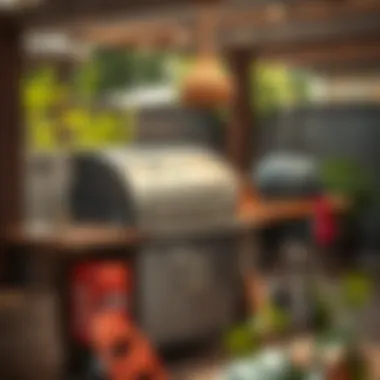Designing the Perfect Barbecue Space for Your Home


Intro
Creating a barbecue area at home is not just about grilling meat; it's about crafting an experience. As outdoor cooking gains popularity, especially in vibrant places like Dubai, having a designated space for barbecue can enhance both your residential property's value and your lifestyle. In this guide, we're diving into the nitty-gritty of designing that ideal barbecue spot, discussing everything from site selection to equipment choices and safety protocols.
It's critical to understand the importance of an inviting barbecue area—not just for personal enjoyment, but also for entertaining guests. Family gatherings, weekend parties, or simple weeknight dinners can all be transformed by the right outdoor space. Let’s unpack the elements involved in creating a beautiful and functional barbecue area that stands out in the competitive Dubai property market.
Market Trends in Dubai Real Estate
Current Market Overview
The Dubai real estate market has been nothing short of dynamic, reflecting trends that emphasize outdoor living spaces. As the demand for homes with flexible layouts rises, residents are starting to envision more than just their indoor spaces. A well-designed barbecue area is rapidly becoming a sought-after feature.
According to local real estate experts, properties with outdoor cooking amenities often see quicker sales and higher offers. In an age where lifestyle amenities are paramount, having a barbecue setup signals to potential buyers that a home is not just a dwelling, but a venue for experiences.
Price Trends and Forecasts
In recent times, property prices in Dubai have experienced fluctuations that are closely linked to availability and the overall economic climate. As outdoor spaces become essential in buyers' checklists, the anticipated forecast shows steady growth in values for homes with enhanced outdoor amenities. Investors and homebuyers alike should keep their eyes peeled for properties integrating these elements, as this is likely to yield better returns.
"Properties with outdoor cooking amenities often see quicker sales and higher offers."
Investment Opportunities
Hot Areas for Investment
When considering investment in properties with barbecue areas, certain localities stand out:
- Dubai Marina: Known for its vibrant waterfront, having a barbecue space is a must-have for hosting parties with stunning views.
- Arabian Ranches: This family-oriented community features many homes with gardens perfect for outdoor cooking.
- Jumeirah Village Circle (JVC): The community’s increasing popularity among younger residents makes it ideal for investment in homes with attractive outdoor features.
Rental Yield Analysis
For property investors, understanding rental yields is crucial. Homes equipped with barbecue areas can often command a premium rental price.
- Dubai Marina stands tall with yields of around 6-7% on average.
- Arabian Ranches, with its family-friendly atmosphere, also showcases attractive yield trends that can be enticing to investors.
- Moreover, properties in JVC typically exhibit strong demand, making them a stable choice for prospective landlords.
In summary, an ideal barbecue area is more than a cooking space; it’s a doorway to enriching the living experience while simultaneously providing financial leverage in the competitive Dubai property market. It’s about realising the connection between quality outdoor living and increased property valuation.
Foreword to Barbecue Areas
Creating a barbecue area goes beyond merely setting up a grill in the backyard. It's about establishing a hub for culinary exploration, social gatherings, and relaxation. This section examines the foundational elements that make outdoor cooking spaces not only functional but also significant in terms of lifestyle and property enhancement.
A well-designed barbecue area invites residents and guests to embrace outdoor living. It transforms the environment, allowing for shared experiences that strengthen bonds. When families cook together, they create memories that last a lifetime. Thus, an ideal barbecue area can serve as the heart of leisure within a property.
The advantages of having a barbecue space extend well beyond the immediate benefits of grilling. It provides an opportunity for healthy cooking practices, encourages spending time outdoors, and can even serve as a point of attraction for potential buyers or renters. In essence, it elevates the overall appeal of your home, making it not just a livable space but a comely retreat from the hustle and bustle of everyday life.
The significance of outdoor cooking spaces
Outdoor cooking areas are treasures, especially in regions with ample sunshine or pleasant climates. They encourage you to embrace the fresh air and enjoy nature while cooking. With grills, smokers, and outdoor kitchens becoming common sights, people are recognizing their value beyond mere leisure. They mix comfort and functionality, allowing you to entertain guests while keeping an eye on your meal.
Some key points to consider about these spaces include:
- Gathering Point: Whether it's the Fourth of July, a birthday, or just a cozy Sunday, grilling brings people together. Everyone loves a good barbecue, and having a designated area sets the stage for these gatherings.
- Health Consciousness: Barbecuing offers a chance to prepare healthier meals. Grilling allows excess fat to drip off, making it a preferred cooking method for many.
- Real Estate Appeal: In the competitive property market, homes that boast a vibrant barbecue area often stand out. It adds value and appeal, making your property more attractive to potential buyers.
Ultimately, outdoor cooking spaces serve numerous purposes and offer significant benefits, both to homeowners and their guests.
Cultural impact of barbecuing
Barbecuing is steeped in cultural diversity and has evolved into more than just a cooking method; it reflects communal traditions, celebrations, and rituals. From the smoky flavors of Southern barbecue in the United States to the traditional asado in Argentina, each culture has its unique style and significance regarding outdoor cooking.
In many communities, barbecue gatherings symbolize bonding and togetherness. The act of cooking over an open flame fosters interaction, invites dialogue, and builds connections. For various cultures around the globe, these gatherings are not merely about the food but about uniting family and friends, sharing stories, and carrying on traditions.
Some notable cultural aspects include:
- Rituals and Customs: Many cultures assign specific meanings to barbecue events, often linked to celebrations or seasonal changes. For example, grilling is a staple for American Independence Day.
- Flavor Profiles: Different regions infuse their local ingredients and techniques into their barbecues, resulting in a kaleidoscope of flavors that tell stories of heritage and innovation.
- Community Bonding: Barbecue events can often bring neighborhoods together, helping in community building through shared meals and interaction.
Thus, establishing a barbecue area doesn't just enhance individual homes; it honors cultures and traditions, encouraging enjoyable experiences in the spirit of togetherness.
Choosing the Right Location
Selecting the right location for your barbecue area is essential. It’s the backbone of the entire setup, affecting everything from the cooking experience to safety and convenience. A well-chosen spot not only enhances the enjoyment of outdoor cooking but also complements the overall aesthetics of your outdoor space. When thinking about where to set up, you should mindfully evaluate space, accessibility to utilities, and privacy concerns.
Evaluating space in the property layout
The physical layout of your property plays a significant role in determining the best place for your grill and dining setup. First things first, take a good look around. Measure the amount of space available and consider how it flows with other areas. An open layout invites social interaction, while a more secluded location may offer a cozy, intimate setting.


When establishing a barbecue area, aim for good separation from high-traffic zones. It’s wiser to avoid having the grill near children’s play areas or where pets roam freely. You want open space, yet you should also consider how far you will need to carry food or equipment. Proximity to your kitchen may streamline the cooking and serving process. Think of it this way: walking that extra ten feet with an armful of meat and veggies can feel like a marathon over time.
Access to utilities and amenities
Having convenient access to utilities is a game changer for outdoor cooking. Water and power connections can elevate a basic grill to a fully equipped outdoor kitchen. Being near a water source means easier cleaning, whether that's rinsing off tools or washing fresh veggies for your grill. A cold drink is a must when barbecuing, and having electricity nearby can help run a small fridge or keep snacks cold.
Consider using options such as:
- Electrical outlets for lights, fans, or cooking equipment.
- Water hookups for easy cleanup.
- Gas lines if you're going for a gas grill.
Having these utilities at your disposal not only enhances functionality but also minimizes trips back and forth into the house. You’ll find yourself becoming a more efficient griller, with everything at your fingertips.
Privacy considerations
No one wants the entire neighborhood tuning into their grill session, so scrutinizing privacy is vital. The last thing you need is prying eyes or unsolicited advice from passersby while you're trying to perfect that rib recipe. Consider the placement of your barbecue area in relation to neighboring houses and common pathways.
You might want to incorporate:
- Tall hedges or fences to provide a barrier and soothe your thoughts of who can see in.
- Trellises or pergolas can create a sense of enclosure without blocking off the beauty of your garden.
Feeling secluded ensures that you can enjoy your outdoor experience without distraction or interruptions, allowing you to focus on what matters most: great food and good company.
In essence, the ideal barbecue spot marries convenience with privacy, providing a seamless cooking experience in a relaxed, inviting atmosphere.
By being deliberate about the location, you'll set the stage for countless gatherings over sizzling steaks and grilled veggies.
Design Elements for Barbecue Areas
Creating an inviting and functional barbecue area starts with the right design elements. These elements play a crucial role in ensuring that your outdoor cooking space not only meets your culinary needs but also enhances the overall aesthetic and experience of your backyard or patio. A well-designed barbecue area can become the heart of your outdoor gatherings, fostering social interaction and encouraging memorable moments with family and friends.
Selecting the Appropriate Grill Type
One of the foundational decisions in designing a barbecue area is choosing the right grill type. This is no small feat, given the variety of grills available today. Let’s break it down:
- Gas Grills: These are popular for their convenience and ease of use. They heat up quickly and offer precise temperature control. Ideal for someone who enjoys grilling but doesn't want to fuss with charcoal.
- Charcoal Grills: Offers a distinct flavor imparted by the smoke. Charcoal enthusiasts appreciate the depth and richness it brings to meats and vegetables. However, these grills typically take longer to heat up and require more cleanup afterward.
- Electric Grills: Perfect for those living in apartments or places with restrictions on open flames. They are compact, easy to use, and can be a great option for small spaces.
- Pellet Grills: Combine features of both gas and charcoal, providing a unique flavor and versatility in cooking methods, including smoking and roasting.
Choosing the right grill is not just about surface level preferences; consider factors like cooking style, location, and frequency of use. A good rule of thumb is to select the grill that best matches your cooking habits and the type of meals you wish to prepare.
Incorporating Seating and Dining Areas
Next up is the integration of seating and dining areas. A barbecue space isn’t merely about cooking; it's also about enjoying meals al fresco. To maximize comfort and encourage conversation, consider:
- Layout and Space: Position seating to allow easy access to the grill without obstructing pathways. A circular or semi-circular arrangement invites interaction among guests.
- Comfortable Seating Options: Invest in durable outdoor furniture, with cushions that can withstand the elements. Materials like weather-resistant wicker or teak combine style with longevity.
- Dining Tables: A generous dining table allows for communal dining. Ensure it’s large enough to accommodate your average group size, yet not too bulky for the overall space.
- Additional Features: Think about adding shade structures, like pergolas or umbrellas, to keep guests cool while they enjoy outdoor meals, making the area more inviting during hot days.
Creating a robust seating and dining area allows for seamless transitions between cooking and enjoying food. It’s also an invitation for guests to gather and share in the culinary experience.
Utilizing Landscaping for Aesthetics
Finally, let’s touch on landscaping and how it can elevate your barbecue area. Strategic landscaping enhances the beauty of the outdoor cooking space while creating a more enjoyable atmosphere. Here are a few ideas:
- Garden Beds: Plant herbs, like basil or rosemary, nearby for easy access while cooking. They add fragrance and charm, making your cooking experience that much richer.
- Pathways: Incorporating stone pathways can guide guests through your outdoor space. They also define the area and provide a neat appearance.
- Lighting: Adequate lighting not only ensures safety during evening gatherings but also sets the mood. Consider string lights, lanterns, or even integrated lighting in your landscaping.
- Privacy Features: Use tall plants or decorative screens to create a secluded feel for your barbecue area, allowing for elevated conversations and an intimate dining experience.
Landscaping is a chance to blend nature with your cooking space harmoniously. By incorporating greenery and well-planned designs, you enhance not only the utility but also the beauty your barbecue space offers.
In summary, the design elements within a barbecue area—appropriate grill selection, comfortable seating and dining setups, and thoughtful landscaping—are pivotal in crafting a space that marries functionality with aesthetic appeal.
For more information on outdoor kitchen design, check out resources on Wikipedia and Britannica.
Essential Equipment for Barbecue Areas
When crafting your ideal barbecue space, a comprehensive understanding of essential equipment is paramount. This framework not only enhances your cooking experience but also ensures safety and efficiency in your outdoor culinary endeavors. The right tools can elevate the quality of your meals and simplify the overall process. So let’s dive into the elements that can turn a simple grilling experience into a memorable feast.
Grill types and their advantages
Choosing the right grill is like picking a ship for a voyage; the wrong choice can lead to a rocky journey. There are several types of grills, each bringing its own flavors and techniques to the table.
- Charcoal Grills: These have been the traditional favorite for many. The smoky flavor imparted by charcoal is unmatched, making it ideal for barbecuing. However, they do take longer to heat and require more maintenance, like ash disposal.
- Gas Grills: They’re convenient, firing up with the push of a button, and they provide better temperature control. This makes them suitable for those who may not want to deal with the nuances of charcoal. However, some argue that they lack the depth of flavor that charcoal grills possess.
- Electric Grills: Perfect for apartments where outdoor space is limited. Electric grills can mimic the grilling experience without the smoke. While they don’t provide the same flavor profile, they are safe and easy to use.
- Pellet Grills: This hybrid option combines wood and electric technology for a unique flavor. They offer a slow cooking method, great for smoking meat.
Each grill type has its pros and cons, and the choice hinges on what you prioritize most when grilling—flavor, convenience, or health.
Storage solutions for utensils and supplies
Having the right supplies is only half the battle if you don’t have a proper plan for storing them. Considerations for storage solutions help maintain organization, ensuring that everything from spatulas to marinades is easily accessible when the time comes to cook. Here are a few innovative ideas:


- Outdoor Cabinets: These can be customized to fit your space and should be weather-resistant. Storing utensils here keeps them out of the reach of the elements.
- Magnetic Strips: For knives and metal tools, these are a space-saver and allow for quick access.
- Rolling Carts: They can be moved around as needed, providing additional preparation space and easy access to all your supplies during cooking.
- Baskets and Bins: Clear bins labeled for specific items can assist in rapid identification of required tools. This can be a game-changer when you're in the heat of preparing a meal.
Having a pre-planned storage solution aids not just in organization, but lessens frustration during those bustling barbecue days.
Considerations for outdoor refrigeration
Refrigeration might not be top of mind when setting up your barbecue area, but it’s in fact crucial. The right outdoor refrigeration solution can help keep your ingredients fresh and your beverages chilled, especially under the hot sun. A few aspects to ponder include:
- Location: Position your refrigerator close to your grill to save time and energy while cooking.
- Size and Capacity: Consider how much food and drink you usually need on hand during gatherings. If your family loves hosting, a larger unit is advisable.
- Type: Outdoor refrigerators must be built to withstand varying weather conditions. Look for those rated for outdoor use.
- Energy Efficiency: An eco-friendly model helps save on energy costs while keeping your fresh ingredients in prime condition.
- Style: Choose a design that complements your overall barbecue aesthetic. The right look enhances functionality and they can become part of the decor.
Efficient outdoor refrigeration isn’t just about convenience; it’s about maintaining the integrity of the food you serve.
"The right barbecue setup can transform a casual cookout into an event that your friends and family will talk about for years."
Maintenance of Barbecue Areas
In the world of barbecue, maintenance holds the key to a rewarding culinary experience. Regular attention to your grilling space not only ensures optimal performance but also extends the life of your equipment and enhances safety for everyone involved. A neglected barbecue area can lead to costly repairs and might spoil the joy of enjoying grilled meals with family and friends. Thus, securing a well-maintained barbecue area is essential for both functionality and pleasure.
Cleaning protocols for grills and surfaces
Cleaning is non-negotiable when it comes to barbecuing. Grime and leftover food particles can become a breeding ground for bacteria – something no one wants at their cookout. After each use, it's best to adopt a routine for cleaning your grill.
- Immediate attention: Once the grilling is done, let the grill cool down slightly but while it’s still warm, clean off the grates. A grill brush can work wonders here. Scrape off any stuck-on residue. This makes the cleaning easier for next time.
- Deep cleaning: The more thorough cleaning should be done at least once a season. Disassemble the grill, cleaning each part separately. Wash grates in warm, soapy water and rinse thoroughly. Don’t forget the exterior surface! Use a suitable cleaner for the grill's material to avoid damage.
- Surface care: For the area surrounding the grill, such as countertops or tables, a damp cloth with mild detergent can remove spills and maintain hygiene. A clean workspace not only looks better but also prevents cross-contamination during food preparation.
Seasonal maintenance tips
As the seasons change, so should your maintenance routine. Each season brings unique challenges, especially when barbecuing outside. Here are some steps to consider:
- Spring prep: After winter, uncover your barbecue area and inspect for damages. Check for rust on the grill, and ensure parts like burners are working effectively. This is the time to replace any broken components.
- Summer checks: During the peak grilling season, fuel levels should be checked regularly. Have extra propane tanks or charcoal ready to avoid running out mid-barbecue.
- Autumn strategies: As temperatures drop, clean the grill thoroughly, and cover it with a barbecue winter cover. This act preserves your investment, preventing rust and damage from the elements.
- Winter considerations: If not in use, it can be wise to periodically check your equipment to ensure animals haven’t nested or moisture hasn’t created issues. Keeping the grill covered will also protect it from winter debris.
Common repairs and solutions
In grill maintenance, it’s not uncommon to face occasional hiccups. When problems arise, knowing how to handle them yourself can save time and money.
- Troubleshooting flame issues: If your flame appears weak or uneven, it could be due to clogs in the burners. Cleaning these with a brush should restore function. If issues persist, inspecting for gas leaks with soap solution might be wise.
- Grate replacements: Over time, grates can wear down. Replacing them is usually straightforward. You might feel a little hesitant, but measuring the old grates to get the right size is key.
- Connector problems: Checking that all hoses and connectors are tight can prevent gas leaks. Ensure everything is tightly secured.
Maintenance of your barbecue area is not just about keeping things clean and tidy; it’s about prolonging the life of your investment and enjoying safe, delicious meals. So gear up, roll your sleeves up, and embrace the necessary upkeep. “An ounce of prevention is worth a pound of cure,” as they say. The joy of barbecuing awaits!
Safety Protocols for Using Barbecue Areas
Creating a barbecue area that is both functional and enjoyable can be overshadowed by safety concerns. Prioritizing safety protocols is crucial to ensure that your outdoor cooking experience remains pleasant and trouble-free. A well-planned space can prevent accidents, uphold food hygiene, and prepare you for any unexpected situations. Therefore, let’s dig into these specific elements that constitute safety protocols when using barbecue areas.
Fire safety measures
When it comes to grilling, fire safety cannot be emphasized enough. Before lighting that grill, it’s essential to ensure that your barbecue area is situated away from flammable materials like wooden fences or overhanging trees. A clear zone of at least 10 feet should be maintained to allow for ample airflow and reduce fire risk.
- Inspect equipment: Regularly check your grill for any gas leaks or damaged hoses. Even a tiny leak can lead to a potential disaster.
- Keep a fire extinguisher nearby: Having a fire extinguisher or a bucket of sand within reach can help you act quickly in case of flames getting out of hand.
- Use long-handled utensils: These tools keep you at a safe distance from direct heat and flames.
Moreover, ensuring that children and pets maintain a safe distance while grilling is a wise precaution. Fire extinguishing protocols should be known by all adult users of the area, which adds another layer of security to your outdoor culinary escapades.
Food safety and hygiene practices
As the saying goes, "an ounce of prevention is worth a pound of cure." This couldn't be truer when it comes to food safety in the barbecue area. Ensuring that food is cooked and handled correctly helps prevent foodborne illnesses and makes your gatherings enjoyable.
- Keep raw and cooked foods separate: Always use separate utensils and cutting boards for raw meat and other ingredients. Cross-contamination can invite unwanted guests like bacteria.
- Use a meat thermometer: This simple gadget can provide peace of mind. Meat should be cooked to the appropriate internal temperatures—chicken should reach 165°F, while hamburgers should hit at least 160°F.
- Refrigerate leftovers promptly: Any food left out for more than two hours should be discarded to prevent bacterial growth.
Regular hand washing, either with soap and water or hand sanitizer if water isn’t readily available, is paramount when preparing food outdoors.
Emergency preparedness
Even with all precautions in place, it’s always wise to be ready for the unforeseen. Preparing for potential emergencies can be the difference between a minor scare and a significant issue.
- Know emergency contacts: Make sure that the numbers for local emergency services and poison control are easily accessible. You never know when you might need them.
- Create a first-aid kit: Equip your barbecue area with a first-aid kit containing band-aids, antiseptic wipes, and burn cream. Accidents do happen, and being prepared can minimize their impact.
- Practice drills: Consider practicing what to do in case of a fire emergency with your family or guests. This ensures everyone knows the plan without needing to think twice when panic sets in.
"In any grilling scenario, flexibility and readiness can be your best friends, ensuring safety without compromising on enjoyment."
In summary, creating a safe barbecue area involves a comprehensive approach—one that considers fire safety, food hygiene, and readiness for emergencies. By doing so, you not only enhance the enjoyment of your cooking space but also protect your loved ones and the environment. The relevance of adhering to these protocols cannot be overstated; a little diligence can go a long way in transforming your outdoor cooking experiences.
Aesthetic Enhancements
Creating a barbecue area goes beyond just functionality; aesthetic enhancements play a vital role in shaping the overall experience of your outdoor cooking space. The visual appeal of your barbecue area can set the mood, encourage social gatherings, and provide a sense of personal style to your home. By transforming your outdoor environment into an inviting culinary haven, you not only elevate the enjoyment of grilling but also enhance the value of your property, particularly in markets like Dubai where outdoor living is highly sought after.
Lighting for evening use


When the sun dips below the horizon, the right lighting can truly make your barbecue area come alive. Consider the type of atmosphere you wish to create. Soft, warm lights often encourage a relaxed ambiance, perfect for dinners with friends or family.
- String Lights: Twinkling fairy lights draped overhead can create a whimsical feel, while also providing enough illumination for nighttime grilling.
- Pathway Lights: These can guide guests safely to your barbecue area, ensuring that everyone arrives in one piece.
- Task Lighting: Equipping grilling stations with focused lights ensures that you're cooking properly, regardless of the time of day.
Lighting serves a dual purpose: it adds beauty and ensures safety. The careful arrangement of lights can help outline spaces without making them feel crowded or overwhelming.
"Good lighting is like dressing your barbecue area in its best attire. It highlights the beauty while ensuring safety, making it perfect for gatherings once the day has passed."
Style considerations for decor
People often express themselves through their home decor, and a barbecue area should be no different. Choose a style that aligns with your personal taste and complements the architecture of your home. Here are a few ideas to consider:
- Bohemian Charm: Utilize bright textiles, colorful cushions, and eclectic decorations to create a laid-back vibe.
- Modern Minimalism: Stick to a sleek design using inbuilt grills and simple furniture, emphasizing clean lines and uncluttered space.
- Rustic Appeal: Incorporate natural materials like wood and stone, and even vintage decor to evoke a warm and inviting feel.
Incorporating thoughtful decor choices can turn your barbecue area from a simple cooking space into a desirable retreat. Include personal touches, like artwork or special souvenirs, to make the area distinctly yours.
Incorporating shade structures
In a hot climate like Dubai, shade is not just a luxury—it's a necessity. Keeping your barbecue area comfortable can influence how much time you and your guests spend there. Shade structures come in various forms:
- Pergolas: These provide an aesthetic focus while offering enough protection from strong sunlight. You can also use climbing plants to create a natural canopy.
- Umbrellas: A practical and easily movable solution, umbrellas come in countless styles and colors to suit any theme.
- Awning: This creates a permanent shaded area, allowing for a blend of indoor and outdoor living.
When selecting shade structures, think about the size and layout of your barbecue area. Additionally, durability is key, so choose materials that can withstand the elements over time.
Barbecue Areas in the Context of Dubai Real Estate
Creating an ideal barbecue area is not just about assembling a grill and setting some chairs outdoors. In the fast-paced realm of Dubai's real estate market, understanding the nuances of outdoor cooking spaces becomes essential. With hot summers and beautiful winters, adding a barbecue area can dramatically alter the appeal of a property. This section delves into the specific elements that impact barbecue spaces, emphasizing market trends, cultural considerations, and investment potential.
Market trends influencing outdoor spaces
In recent years, an uptick in the awareness of outdoor living zones has reshaped how investors and homebuyers view properties in Dubai. Those looking for properties are no longer satisfied with just a roof over their heads; they crave lifestyle enhancements. Outdoor barbecue setups have turned from being optional add-ons into major selling points.
- Emerging Preferences: Many families are gravitating towards homes with dedicated outdoor cooking areas, enabling spaces that foster social interactions and gatherings.
- Integration of Amenities: Properties featuring barbecues often come with associated elements like outdoor kitchens, shade structures, and dedicated seating, which can significantly enhance the home’s allure.
- Year-Round Usage: The favorable climate during specific months prompts many owners to use these areas regularly, making them a vital part of the residential experience in Dubai.
Investors eye these trends closely, as they signal growing demand in the property market for integrated outdoor living experiences. Homes that incorporate thoughtful barbecue designs tend to appreciate over time, making them a smart investment choice.
Cultural factors affecting design choices
Dubai’s multicultural environment plays a central role in shaping the design and functionality of barbecue areas. The diversity of residents influences not just culinary preferences but also social norms surrounding outdoor cooking.
- Culinary Influences: The blend of various traditions creates an eclectic palette of grilling styles. From Middle Eastern kebabs to Asian barbecued skewers, the designs must accommodate varied cooking methods and preferred cuisines.
- Social Gatherings: In many cultures, grilling is intertwined with hospitality and communal dining. This understanding can drive the layout and size of outdoor areas to ensure they are conducive to large gatherings.
- Aesthetic Choices: The design often reflects local tastes—think elegant finishes that resonate with both traditional and modern architectural styles prevalent across Dubai.
These cultural threads stitch together the common understanding of what an ideal barbecue area should look like, further tailoring it to cater to both residents and visitors alike.
Investment value of outdoor cooking areas
In regions where outdoor spaces thrive, barbecue areas can enhance a property’s intrinsic value. Buyers consistently seek homes that reflect an investment in lifestyle, making the addition of a well-designed barbecue zone a savvy choice.
- Increased Property Appeal: A thoughtfully designed barbecue space can tip the scales when buyers weigh options during house hunting.
- Potential for Higher Resale Value: Properties that already have established outdoor cooking areas often experience elevated market value, translating to a return on investment when it’s time to sell.
- Attracting Tenants: For investors renting out properties, well-equipped barbecue areas can attract tenants willing to pay a premium for these features, ensuring consistent occupancy rates.
Future Trends in Barbecue Area Design
As we venture into an era where outdoor living spaces are becoming extensions of our homes, the significance of barbecue area design is more pronounced than ever. Future trends are critical in shaping these spaces to reflect both functionality and innovation. Homeowners, investors, and real estate agents alike must recognize that a well-designed barbecue area not only elevates the overall aesthetic of a property but also enhances its market value. The trends discussed in this section aim to provide insight into how emerging technology, sustainability, and smart integration can be harnessed to create the ideal culinary escape outdoors.
Emerging technologies in outdoor cooking
The way we cook outdoors is rapidly evolving, driven largely by technological advancements. New grilling equipment and cooking appliances are now designed with precision and ease in mind. Smart grills can connect to apps for programming and monitoring, allowing a deft cook to achieve perfect results with minimal effort. For instance, models like the Weber Connect Smart Grilling Hub enable users to control their grill directly from their smartphones.
Moreover, innovations such as infrared grilling and pellet smokers are gaining traction. Infrared technology, which cooks food evenly by using high heat and minimal fuel, is becoming a favorite among barbecue aficionados. This heats up faster and reduces cooking time, perfect for impromptu gatherings. Likewise, pellet smokers add a unique flavor profile to food and offer versatility in how meals are prepared.
These advancements not only portray a commitment to quality but also reflect consumer preferences shifting towards convenience and precision in outdoor cooking.
Sustainability considerations
In a world increasingly aware of environmental impact, the sustainability of barbecue area designs cannot be overlooked. Consumers, especially millennials and Gen Z, are more inclined to invest in green options that reduce their carbon footprint. This creates a significant opportunity for developers to integrate eco-friendly materials and appliances into outdoor cooking spaces.
One of the most straightforward yet effective ways to promote sustainability is through the use of solar-powered grills. They harness natural energy, significantly reducing reliance on propane or charcoal. Likewise, utilizing reclaimed wood for construction, along with energy-efficient lighting systems, can minimize waste and reduce the environmental impact of these areas.
Furthermore, incorporating efficient waste disposal systems and composting stations can contribute to a more sustainable barbecue environment, promoting responsible usage of resources.
Integration with smart home systems
The concept of the smart home extends seamlessly into outdoor living spaces, including barbecue areas. By integrating cooking stations with existing smart home systems, homeowners create an environment that fosters both convenience and sophistication. Smart technology facilitates a streamlined approach to outdoor cooking, whether it be monitoring grilling temperatures, tracking ingredient inventories, or automating lighting and aesthetics.
For example, having a digital home assistant available outdoors can allow users to adjust grill settings hands-free or access recipes with ease. Furthermore, smart lighting that syncs with the time of day can create an inviting atmosphere without the inconvenience of manual adjustments.
Investors and homebuyers should consider the demand for outdoor areas that easily meld with smart technology. As more consumers seek convenience, properties with integrated systems will likely fetch higher interest and value.
"The future of barbecue areas is not just about cooking meat; it's about cooking smartly."
By recognizing these trends in barbecue area design, stakeholders can position themselves favorably in a competitive market. The elements of emerging technology, sustainability, and smart systems not only enhance the user's experience but also align with contemporary values, making these spaces attractive to a wide array of potential buyers.















